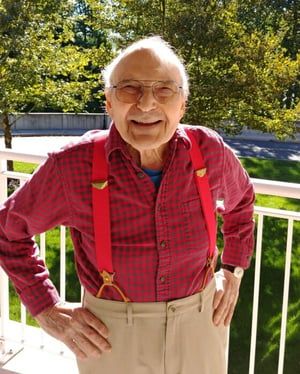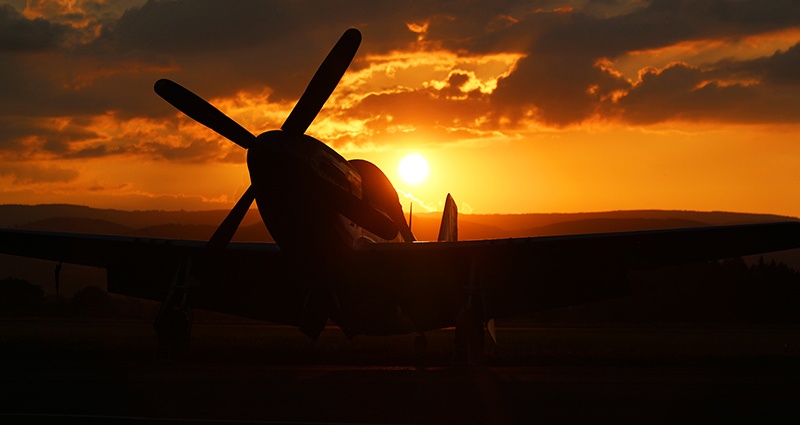There are many interesting people enjoying retirement life at Kendal on Hudson, including Pulitzer Prize winners, accomplished authors, artists and more. Recently, we spoke with a World War II fighter pilot who was kind enough to share some of his gripping stories.
Bill, a resident of Kendal on Hudson, told us about his time during the war and what a day in the life of a fighter pilot was like during those turbulent times.
The Call to Join
Before Bill decided to join the military and fight in World War II, he was living in Brooklyn, New York and working at Sperry Gyroscope Company. At the time, Bill was only 18 years old and his mother reluctantly gave him permission to join.
“I felt it was my patriotic duty to join,” Bill explained. “A war was going on and we were very concerned about Hitler, and then Japan bombe
d Pearl Harbor. We also knew that Hitler was doing harm to the Jews and as a Jewish man, that really concerned me. We didn’t know about the concentration camps at the time.”
Bill joined the U.S. Army Air Corp and trained to be a fighter pilot. He became a first lieutenant assigned to the 357th Squadron, 355th Fighter Group, Eighth Air Force and was stationed at Steeple Morden, England. Steeple Morden was a tiny village in England composed of about 400 people. The airfield was carved out of a wheat field. The Bassingbourn airfield that housed the B-17’s (U.S. heavy bombers used in World War II) that Bill and his fellow pilots were assigned to protect during their missions was only 5 miles away.
A Day in the Life of a Fighter Pilot
On mission day, Bill and the rest of the fighter pilots would awake around dawn to get prepared.
“You could hear the B-17s starting their engines and warming up in the distance. That’s how you knew it was mission day,” Bill said. “I would get dressed, head to the latrine to wash up and then ate breakfast with the rest of the pilots. We would then be taken by Jeep to head to the briefing room to listen to what our mission was for the day.”
Upon entering the mission room, the pilots would sit in front of a wall covered in a shroud. Once the briefing officer entered the room, the shroud would be pulled and a
map of the mission would be revealed.
“Our purpose was to escort the bombers to and from their mission,” Bill explained. “The bombers’ targets were German war manufacturing facilities such as oil refineries, airfields and jet manufacturers.”
Once the briefing was completed, the pilots would go to the Ready Room to put on their flight suits and parachutes, and prepare for their missions. Once the pilots were ready, a Jeep would then transport them to their planes.
“We flew the P-51 Mustang which was a single engine, propeller driven fighter plane,” Bill said. “The P-51 Mustang was equipped with six .50 caliber guns that could shoot at a target 250 yards away. But, you had a better chance of shooting your target down the closer you got to them.”
Each mission could involve anywhere from 500 to 1,000 bombers with 300 to 500 fighter planes to protect them.
“Not only was it our job to protect the bombers, but we also had a responsibility for each other. We could count on each other and it was a tight group. I made friendships that lasted for my entire life,” Bill said.
Life After the War
After clocking 300 combat hours, pilots were allowed a 30 day leave back to the U.S.
“I had completed 63 missions and was able to go on home leave,” Bill said. “While I was on leave, May 8, 1945, VE Day happened. I was given the choice to either go to Japan or be honorably discharged from the military. That’s when I learned of the G.I. Bill and decided I would move on from military life and go to college.”
Bill had always wanted to go to the Massachusettes Institute of Technology (MIT) and he got in. He first went to college to study aeronautical engineering, but found that he really enjoyed his humanities courses.
“I had a Psychology course that I really enjoyed and my professor suggested I would do really well in mass persuasion or advertising,” he said. “As a junior at MIT, you had to pick a 3-by-5 card off of a board that had a real-life problem for a big company such as General Electric or Dow Chemical, and you had to solve that problem for them. None of the cards interested me, except for a yellow card that was hidden behind the white cards. This yellow card had a problem from the Necco Wafers Company that wanted to increase the sales of their 5 cent candy bars. This problem interested me so I chose it as my senior thesis.”
Bill received honors on his thesis and discovered his love for advertising. He went on to work for various advertising agencies during his career.
Retirement at Kendal on Hudson
Bill and his wife, Carol, decided to move to Kendal on Hudson after living on a mountainside in Irvington, New York. They loved their single-family home, but the road to get to their home was dangerous.

“Driving on this road to get to our home was becoming very concerning, especially during the winter months,” Bill said. “We loved our home, but we knew it was time to look into retirement communities.”
Bill and Carol heard about Kendal on Hudson while they were at a doctor’s appointment at Phelps Hospital. They decided to investigate the community and made a cold call.
“We were really taken by the place,” Bill explained. “The Hudson River view is amazing! When we did a walkthrough, the residents were active and were very welcoming. We knew this was the place for us.”
Shortly after, Bill and Carol decided moved in. The hardest part of the move was downsizing and preparing to move with fewer belongings.
What do Bill and Carol enjoy the most?
“The people,” Bill said. “We have made new friendships and still have our friends from before moving to Kendal on Hudson.”
Carol also shared her favorite part of Kendal on Hudson.
“There are so many friendships made among women here,” she said. “If you have an interest and there isn’t a group for it, you are encouraged to start a group around that interest.”
“We also enjoy all of the activities. They certainly keep us busy around here!” Bill said with a laugh.
Share this article with your friends!












